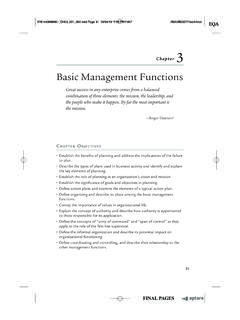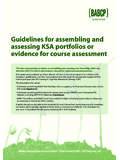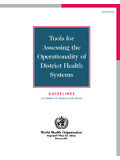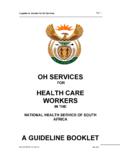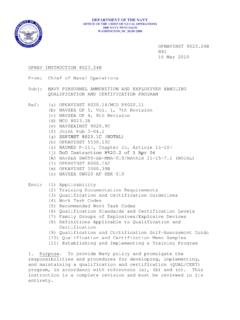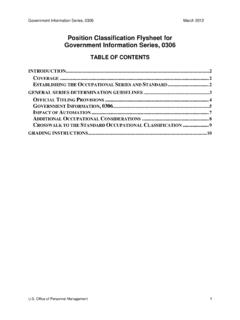Transcription of Implementing Evidence-Based Nursing Practice: …
1 Jones & Bartlett Learning, LLC. NOT FOR SALE OR DISTRIBUTION. Chapter 5. Implementing Evidence-Based Nursing Practice: An Overview Getting Started To start, let us review the definition and description of Evidence-Based nurs- ing practice presented in Chapter 1. Evidence-Based practice (EBP) definitions are varied, but all include evidence from three broad areas: empirical studies, other forms of published evidence ( , review articles, clinical pathways, pro- tocols), available clinical expertise and resources, and patient preferences/. nuisances. Melnyk and Fineout-Overholt (2005) define EBP as a problem- solving approach using current best evidence to answer a clinical question in- corporating one's own clinical expertise and patient values and preferences. As I presented in Chapter 1, I would argue that a better term to differentiate the uniqueness of Nursing practice from other disciplines would be Evidence-Based Nursing practice (EBNP) and will refer to it as EBNP from this point on.
2 Evidence-Based Nursing Practice Models Several models have contributed conceptually to the implementation of Evidence-Based Nursing practice. The Stetler model (Stetler, 2001), the Iowa model (Titler et al., 2001), the John Hopkins Evidence-Based Practice Model (Newhouse, et al., 2007), the ACE Star Model (Stevens, 2004), the Caledonian Development Model (Tolson, Booth, & Lowndes, 2008), and the evidence - based Practice Model for Staff Nurses (Reavy & Tavernier, 2008). Three of the most common models used today are discussed next. The Stetler model, first developed in 1976 and refined in 1994, went through an update in 2001. Five phases are included in the process of performing EBNP. (Stetler, 2001): 1. Preparation This phase includes the identification of the problem/issue and validation of the problem with evidence . 75. 7004. Jones & Bartlett Learning, LLC. NOT FOR SALE OR DISTRIBUTION. 76 Chapter 5 Implementing Evidence-Based Nursing Practice 2.
3 Validation Critique and synthesis of the evidence (empirical and non- empirical evidence , systematic reviews, etc.). Rate the level and quality of each item of evidence using a table of evidence . Eliminate noncred- ible sources. Process ends here if there is no evidence or it is clearly insufficient. 3. Comparative evaluation/Decision making Synthesize the cumulative findings. Make a decision about what can be used. At this point, there is an option to conduct own research if findings cannot be used. 4. Translation/Application Decide on what level of application (individ- ual, group, organization). Develop proposal for practice change. Create strategies for formal dissemination and planned change. Consider a pi- lot project. 5. Evaluation Evaluation can be formal or informal. Consider costs. In- clude both formative and summative evaluations of outcomes. The Iowa model starts with a trigger/problem. These triggers may be knowl- edge focused or problem focused.
4 If the problem is a priority for the organization, then a team is formed. The team is composed of key stakeholders, clinicians, staff nurses, and other champions of Evidence-Based practice. The next step is synthesizing the evidence . A pilot of the practice change occurs if there is suffi- cient evidence to support the change. Evaluation of outcomes and dissemination of findings would follow. The Iowa model is depicted in Figure 5-1. Hermes et al. (2009) used the Iowa model to develop an Evidence-Based imminent suicide risk instrument. The trigger for the project began with the decision-making process for placing patients on suicide watch. Nurses ques- tioned whether the current protocol was accurate in identifying patients at risk. The second step was determining if the topic was a priority for the orga- nization. All members of the unit- based council believed it was important to examine the appropriateness of the current tool.
5 The third step was to form a team, which included two staff nurses from the unit- based council to lead the team, two clinical nurses to complete the project, and the hospital's Nursing re- search facilitator who served as advisor to the project. The fourth step involves assembling and analyzing the research. This process included 11 studies that addressed assessment of suicide risk in an inpatient setting. A grading schema used to grade the quality of evidence included the following system: A evidence from well-designed meta-analysis or integrated literature reviews B evidence from well-designed controlled trials, both randomized and nonrandomized C evidence from observational studies, such as descriptive and correlational D evidence from expert opinion or multiple case reports 7004. Jones & Bartlett Learning, LLC. NOT FOR SALE OR DISTRIBUTION. Getting Started 77. Figure 5-1 The Iowa Model of Evidence-Based Practice to Promote Quality Care.
6 Problem-Focused Triggers Knowledge-Focused Triggers 1. Risk-management data 1. New research or other literature 2. Process improvement data 2. National agencies or organizational 3. Internal/external benchmarking data standards and guidelines 4. Financial data 3. Philosophies of care 5. Identification of clinical problem 4. Questions from institutional standards committee Key: = A decision point Consider Is this logic No a priority for the other triggers organization? Yes Form a team Assemble relevant research and related literature Critique and synthesize research for use in practice Yes No Is there a sufficient research base? Pilot the change in practice Base practice on Conduct 1. Select outcomes to be achieved other types of evidence research 2. Collect baseline data 1. Case reports 3. Design EBP guideline(s) 2. Expert opinion 4. Implement EBP on pilot units 3. Scientific principles 5. Evaluate process and outcomes 4. Theory 6.
7 Modify the practice guidance Continue to evaluate Is change No appropriate for Yes quality of care adoption in Institute the change in practice and new knowledge practice? Monitor and analyze structure process, and outcome data Environment Disseminate results Staff Cost Patient and family Reprinted with permission from Titler et al. (2001). The Iowa model Evidence-Based practice to promote quality care. Critical Care Nursing Clinics of North America, 13(4), 497 509. University of Iowa Hospitals and Clinics. 7004. Jones & Bartlett Learning, LLC. NOT FOR SALE OR DISTRIBUTION. 78 Chapter 5 Implementing Evidence-Based Nursing Practice In the sample study, most evidence was rated C or D. A critical analysis of the evidence is part of the fourth step. The fifth step is determining if there is enough evidence to pilot the practice change. The team decided that there was sufficient evidence to move forward as a unit- based quality improvement initiative.
8 The hospital librarian assisted with literature searches to find an instrument that would contain questions about suicide ideation but also as- sess for signs and symptoms of anxiety and agitation. The Behavioral Activity Rating Scale is helpful in assessing agitation in this patient population. Items from the Hamilton Anxiety Scale, used in a previous study on this unit, were added to the Behavioral Activity Rating Scale. A pilot test of this instrument followed. The sixth step is Implementing the practice change into practice. This step included approval from the forms committee at the hospital and inten- sive in-service education for all staff nurses involved. To evaluate outcomes 6. weeks after the initial implementation, a representative of the unit- based coun- cil questioned staff nurses about their satisfaction with the new instrument. The ACE (Academic Center for Evidence-Based Practice) Star Model is an- other frequently used Evidence-Based practice model.
9 Visually depicted (Fig- ure 5-2 ), it presents a framework for understanding the relationships between Figure 5-2 The ACE Star Model. 1. Discovery n S. 5. tio 2. um ua m E va l ary nt eg tio n I. rat la i on ns Tra 4 3. Reprinted with permission from Stevens, K. R. (2004). ACE Star Model of EPB: Knowledge Transformation. The University of Texas Health Science Center at San Antonio: Academic Center for Evidence-Based Practice. 7004. Jones & Bartlett Learning, LLC. NOT FOR SALE OR DISTRIBUTION. Getting Started 79. various stages of knowledge transformation. Knowledge transformation is de- fined as the conversion of research findings from primary research results, through a series of stages and forms, to impact on health outcomes by way of Evidence-Based care (Stevens, 2004). It provides a framework for systemati- cally putting Evidence-Based practice processes into action. Each point of the star represents a stage of knowledge transformation: 1.
10 Knowledge discovery new knowledge discovered through traditional empirical research including both quantitative and qualitative studies 2. evidence summary synthesizing across the research over a partic- ular issue or problem; includes findings from systematic reviews and meta-analyses 3. Translation into practice recommendations summarized research evi- dence is combined with other sources of evidence such as clinical exper- tise; then this holistic evidence is translated for the specific population and setting 4. Integration into practice Implementing the practice change through formal and informal methods; taking into account individual and orga- nizational factors that affect adoption and integration into the system 5. Evaluation includes the evaluation of the practice change on patient health outcomes and provider and client satisfaction With the exception of the ACE Star Model, other models described in this discussion offer a sequential, step-wise approach to moving evidence into prac- tice.









